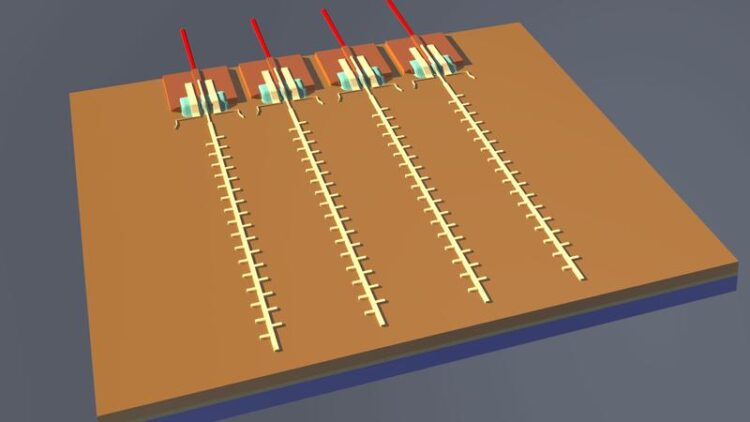Implementing Optical Chips

Photonic integrated circuit (PIC) for Terahertz beam steering.
UDE/A. Stöhr
4 Million € for European Training Network
They can emit, detect, modulate and store light to receive and process high-frequency terahertz radiation – in theory. So far, only individual components of optical chips have been developed; there still remain some challenges before complete circuits based on photons will be available. These challenges are now being met by the European Training Network TERAOPTICS, coordinated by engineers from the University of Duisburg-Essen (UDE). The EU provides four million euros in funding for the project until 2024.
Using special technology, light can be converted into high-frequency terahertz radiation between 0.3 and 10 THz. “This technology is very promising, for example for future mobile communications networks, security technology or space flight,” explains Prof. Dr. Andreas Stöhr from UDE’s Centre for Semiconductor Technology and Optoelectronics (ZHO), who coordinates the network. PhD students from universities and research institutes all around the world and from several European industrial companies are investigating various aspects of the technology in 15 subprojects.
They want to develop optically integrated semiconductor chips, i.e. circuits that work with photons instead of electrons. This would allow THz signals to be generated and processed with greater efficiency and precision – a fundamental advantage, for example, for materials analysis or the transmission of extremely high data rates by radio. “But optical systems developed to date are generally too complex and ultimately too expensive as well,” Stöhr summarizes the current situation.
Combination of Different Material Systems
One of the biggest challenges is the assembly from different material systems, because unlike entirely silicon-based electronic chips, the components of the optical technology need different carrier materials and must yet function in an integrated system. Consequently, there is also a need for research in the design of the chips, their microstructuring, and in interconnection and assembly technology. “A prerequisite for as many innovative solutions as possible is the ability to miniaturize an optical system and produce it cost-effectively,” the coordinator states.
TERAOPTICS is the first European Training Network coordinated by the UDE. How great the interest in the topic is, is reflected in the large number of associated partners, including the European Space Agency ESA, the European Association of Photonics Industries, but also many start-ups and small companies. The EU supports the network as part of the Marie-Skłodowska-Curie program within Horizon 2020.
Editor: Birte Vierjahn, +49203/37 9-2427, birte.vierjahn@uni-due.de
Wissenschaftliche Ansprechpartner:
Prof. Dr. Andreas Stöhr, Optoelectronics, +49 203/37 9-2825, andreas.stoehr@uni-due.de
Weitere Informationen:
http://w3w.oe.uni-due.de/start/about/presse/200904_photonic_LWA.asp?l=de First demonstration of an optically integrated chip for 6G communication (Video)
https://teraoptics.eu
Media Contact
All latest news from the category: Power and Electrical Engineering
This topic covers issues related to energy generation, conversion, transportation and consumption and how the industry is addressing the challenge of energy efficiency in general.
innovations-report provides in-depth and informative reports and articles on subjects ranging from wind energy, fuel cell technology, solar energy, geothermal energy, petroleum, gas, nuclear engineering, alternative energy and energy efficiency to fusion, hydrogen and superconductor technologies.
Newest articles

A new experimental infection model in flies
…offers a fast and cost-effective way to test drugs. Researchers at the Germans Trias i Pujol Research Institute and Hospital have reinforced their leading role in infectious disease research by…

Material developed with novel stretching properties
KIT researchers produce metamaterial with different extension and compression properties than conventional materials. With this material, the working group headed by Professor Martin Wegener at KIT’s Institute of Applied Physics…

Can AI improve plant-based meats?
Cutting back on animal protein in our diets can save on resources and greenhouse gas emissions. But convincing meat-loving consumers to switch up their menu is a challenge. Looking at…



